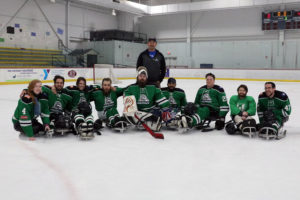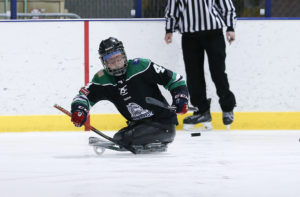Women’s sled hockey player brings tools learned in a swimming pool to the frozen pond
Rachel Grusse, 28, of Vernon, Conn., has kept both the adaptive and non-disabled sports worlds wondering what’s next over the course of her athletic career.

As a double below-the-knee amputee, she has played able-bodied soccer, competed twice at the Move United Junior Nationals (formerly Adaptive Sports USA Junior Nationals) as a swimmer and even tried handcycling.
“I’m much more competitive with myself than anyone else,” Grusse said. “One thing I learned early on by swimming against non-disabled people is I was never really in a position to compete.”
When she started racing for the Hospital for Special Care’s WAVE Swim Team, the playing field equalized.
“I could be successful overall,” she said.
Prior to her life on the ice, she was the first adaptive swimmer from her state to compete in the East Coast Zone Championship meet, and in 2006, Grusse set the American record for the 200-meter backstroke to top her S8 classification.
But Grusse said missing the 2008 U.S. Swimming Paralympic team worked in her favor because she found wheelchair basketball, and the team aspect of it made sled hockey more attractive. She switched to sled hockey in 2012 and is currently a player with the Northeast Sled Hockey League (NESHL).
She plays as a forward with the Gaylord Sports Association’s Wolfpack co-ed sled hockey team and is an up-and-coming leader on the U.S. Women’s Development Team.

After developing her cross-checking and puck handling skills in three years in the NESHL, Team USA’s Kelly Lavoie and Karen Smith encouraged her to try out for the national team.
“I instantly loved it. Being able to say I’ve played against Team Europe and Team Canada is awesome,” she said about facing off in Norway, Vancouver and the Czech Republic. “It was cool to see girls playing a male-dominated sport in other countries, too.”
In its 2019-2020 season, the NESHL was made up of 227 players and of that number, 14% were women across the league’s 15 teams.
“Anytime I find out that a girl is interested, I tell her she has to try this,” Grusse said.
She explained that what people don’t realize about women’s sled hockey is that “we are just as physical.”
“It is a huge part of it, because it is difficult to steal the puck from another player by stick checking – you have to hit them,” she said. “I also feel like it’s another way to show our strength.”
Read And React
Strategically, things can go sideways in hockey, and Grusse stressed that as a team, it is important not to rely on positioning.
Sled hockey players use sleds mounted on hockey skate blades and two sticks with picks on the ends. Balance in the sled is the hardest to get used to, said NESHL Commissioner Mike Ciavarro, who was a defenseman on a Boston men’s league before being injured at age 47 in a construction accident.

For Grusse, who grew up without legs because of an infection at 16 months old, the use of a smaller sled means the advantage of a short turning radius. However, she said learning how to use the sticks to propel herself took some work.
“When you are moving, your hands should be at the top of the sticks. Then, if you’re puck handling, you move them to the bottom. I dropped my sticks a lot in the beginning,” she admitted.
Grusse said hockey players can be hotheaded, but their camaraderie makes it come together.
“The best feeling in the world is not when I score, but when I make a great pass with my teammates and it ends up in a scoring situation,” she said. “One player can’t play the entire game, so we all have to play well, and we encourage each other.”
Family First
Katie Joly, who manages and directs the Gaylord Sports Association that sponsors the Wolfpack, said it important to have a person like Grusse on a team.
“Not only is Rachel a talented athlete in many sports, she is just a really genuine and kind person,” Joly said. “She volunteers to help out with team tasks, enjoys teaching new players and recruiting.”
“She is very personable,” Ciavarro said. “Rachel is also an extremely hard hitter, and the guys all treat her like a competitor.”
Both Ciavarro and Grusse hope women’s sled hockey becomes a Paralympic sport, but Grusse is happy with small improvements toward big goals.
“This sport takes a lot of practice and endurance to be successful,” Joly said. “But I think immense passion and love is what drives our players. The team also becomes an extended family, giving players confidence to work toward their goals outside of sled hockey, too.”
Grusse said a few broken fingers, plus having her hand skated over once, won’t stop her from giving her best to the sport.
“I love sled hockey because I can always learn something from my teammates that improves my game,” she said.
For More
Grusse was featured in a short feature film called, “My Really Cool Legs” (2011)
Information about the sled hockey programs mentioned in this article can be found:
https://www.gaylord.org/Community-Sports-Assoc/Sports-Association/Sports-Teams/Sled-Hockey
https://www.neshl.org/about-neshl/board-of-directors-league-officers